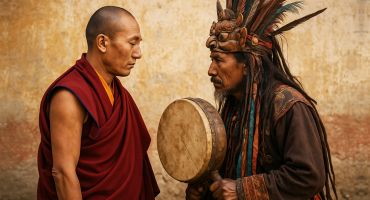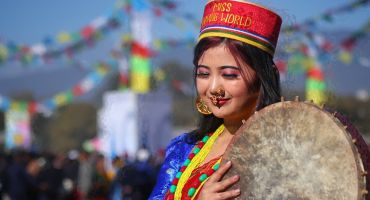Mangkhims are temples of the Kirati Khambu Rai people. These modern-day structures, built to house the holy hearthstones, are a modern introduction – an attempt to resurrect Khambu Rai animistic traditions and somewhat organize its Shamanic religion. Mangkhims are both traditional and reformed. They are built to accentuate ethnic Khambu Rai traditions of ancestor worship as well as other early beliefs. That which is distinctive in Khambu heritage should surely be reflected in its design for Khambus cannot express their traditions properly until they are free from other religious influences to which, for reasons unknown, they still tend to cling. Hence the veneration and the construction of the Mangkhim became prevalent to restructure this idea of reformed configuration. However, they reveal a discontinuity of traditional Khambu ideology.
Khambu Rai tradition entails two principal creeds – ancestor reverence and nature worship. All nature-worshipping rituals, which are public ceremonies, are performed by the Shaman (Mangpa), and rites related to ancestor worship are performed on the hearthstones, by the elder of a particular kin group, inside the house. These hearthstones are the sanctum sanctorum of the Khambu Rai people. Known as Samkhalung or Suptulung, Hearthstones are at the core of Khambu cultural identity. A Mangkhim attempts to imitate this sanctum by placing similar hearthstones as the central shrine.

However, the Suptulung placements of most Mangkhims, unlike the universal model they embody, are inexpedient, directionless, and erroneous. Khambu Rai homes have Hearths made up of 3 upright stones on the ground. While these three stones are visible, the Suptulung is a combination of 8 stones, and their spiritual significance and bio-geometry are generally accepted. But what one must understand here is that a Suptulung is not just an altar. It is in fact, also the kitchen hearth. Called Chula Dhunga, in colloquial Nepali, Suptulungs serve as ritual altars and as hearths to cook food. In modern times, traditional stone hearths and kitchens have become obsolete, and the Suptulung has been relegated to function only as an altar and become a religious symbol.
While the Khambus have always attempted to return to the imagined simplicity and a sense of community enjoyed by the ancient age, many modern Mangkhims have removed those grounded Samkhalungs and instead built tiered pyramid pedestals upon which those hearthstones now stand. Although the concept of Mangkhims remains fundamentally traditional, the introduction of these rectangular pedestals undermines the model of the Suptulung in its original form. Where has there ever been a kitchen hearth that’s out of reach?

‘This kind of adjustment of conceptual categories is also encountered in the symbolic function of the domestic hearth (daplo). Indeed, although its location in some way forms the crossing of the ground floor diagonals (the dwelling’s geometric center), the Kulunge define the hearth as the “center” (mrap tusko) of the ground floor.’ – Martino Nicolleti, The Ancestral Forest
A Sutptulung has always been symbolic of having derived its essence from Sumnima, the primeval mother ancestor, a human manifestation of the earth. Shamans use Mundhum (ritual language) to dedicate rituals in witness of the divine Neenamma and Henkhamma, sky and earth. But these tiered sanctums, introduced through Mangkhims downplay or even deny the concept of sacred earth and reject the idea of Sumnima, as the primordial ancestor.
Most Mangkhim sanctums have considered the Khambu Suptulung an unreachable ideal. This is evident in those tiered pedestals plastered with decorative tiles and adorned with flowers, gingers, and water grails ‘offerings’. This is the wrong interpretation of the very concept of Khambu Suptulung and shows how contemporary Khambus have misunderstood its essence. For most Khambus who are influenced by Hindu symbols, tiered Suptulungs somehow represent the Yajna Vedi or Kunda. But a few understand that these tiered structures that became the norm in Mangkhims, come from the Limbu religious Den pyramid. The Limbus believe there are nine worlds (Dens) above the earth and nine below in this universe. The earth stands in between these worlds. The Limbus have tiered representations of these Dens inside their Mangkhims.

‘There are no idols in these Mangkhims but we find nine steps constructed in the form of a pyramid. Oil lamps or candles are lit and kept on the four corners of each of the steps. They pray with ‘Lasari’, a brass plate with Artemisia flower twigs with silver coins, grains of rice, etc kept on the top of the nine-step altar. Limboos make three rounds with the dhoop in hand starting from the right side of the altar and pray to the Almighty facing the eastern side, standing on the western side of the altar.’ – Jayaraman Suresh, The Religion and the Socio-cultural Life of the Limboos of Eastern Himalayas
Exalted as the tiered pyramid is, it is by no means aligned with Khambu traditions, beliefs, and practices. So, why were these tiered structures of the Limbus copied? Well, ignorance! One of the first Mangkhims ever built was by Kirat Rai Yayokha (Khambu Rai organization of Nepal) at Hattiban, Lalitpur, Kathmandu. Unbeknownst to most Khambus from Darjeeling, this Mangkhim was built together by the 4 Kirati communities, Khambu, Limbu, Yakha, Koits, and houses religious items and symbols of all four communities.
This Mangkhim has four entrances, and each opens up to the central chamber. Each entrance belongs to each of the aforementioned Kirati groups. While all doors lead to the same inner chamber, the first thing one sees through a particular door is that group’s religious symbol. For example, the eastern door is for the Khambus, and when opened, the first thing one sees is the Hearthstones, Suptulung, firmly centered on the ground. However, as one approaches the Mangkhim, the immediate door is that of the Limbus, and when one opens it, the first thing witnessed is the tiered Den pyramid of the Limbus. Many Khambus, without any prior knowledge of this, started to believe that this tiered Den pyramid is the standard model of any Mangkhim. Without proper scrutiny and inquiry, they returned to Darjeeling and copied this pyramid structure.

The intersection between lofty shrines and the spiritual dimension is difficult to define since it is subjective and dependent on belief systems. We cannot say for sure that Khambus can easily see the sacred in a Mangkhim’s noble grandeur. Many traditional observers find it amusingly ironic that simple ‘kitchen’ Suptulung grounded in Henkhama would imitate temples designed as Yajna Vedis that allow incense smoke and flower-fruit offerings. Common sense dictates that the hearth, in any culture, house, or place of worship, is always on the floor. According to Khambu traditions too, it must be placed on the ground and at the center, and represent a modest, simple shrine rather than a grand multi-level structure.
Although many Khambus argue that there is no pre-defined way to construct a Mangkhim, its architecture needs more speculations and study. We must understand that Mangkhims might be a modern introduction but it’s certainly not the first house of worship that the Kirati Khambus have ever built. Gopalavamshali is a historical document that corroborates the claim that the Kirati civilization flourished in Nepal valley for 1903 years until its fall in around 50 AD. Would a civilization that lasted for almost two millennia not build any temples? Historical evidence suggests that they did.
According to Licchavi inscriptions, 24 temples constructed by the Lichhavis still stand today. The Lichchavis used specific suffixes to denote the Gods. Swami was used to denote Vishnu, Iswara to denote Shiva, Deva to denote Avatars, and Devakula to denote non-Aryan temples. Kirata temples that existed in the pre Lichhavi era have been referred to as Matindevkul, denoting the worship of a female (mother) goddess or deity.
It would be a stretch to seek ancient historical remnants to inspire Mangkhim design, but it does offer some useful information. A Mangkhim must always adhere to the principles of sacred architecture. Within the Mangkhim chambers, rituals are supposed to play a big part. Traditional Khambu households too become an integral part of rituals. If historical guidelines are not relevant anymore, we can still use simple architectural and traditional principles employed while building Khambu houses.

‘All of these household rites, have in common the fact that they refer not only to the house as a social group but also equally to the house as such: in all of them, the latter becomes a temple’ – Martin Gaenszle, Origins and Migrations: Kinship Mythology and Ethnic Identity among the Mewahang Rai of East Nepal.
Architectural ideas, both correctly and incorrectly used in contemporary Mangkhims, are endless. Khambus must attempt to discover some guidelines. Of course, not all will agree that anything needs to be added to the main structure of the Mangkhim but placing the Suptulung hearthstones on the floor is vital if authentic traditions are to be preserved and reclaimed. This must be the first reform that the Khambus must undertake. Impractical tiered pyramid Suptulung is not primarily the result of overlooking traditions—however much those abound. No, such error is the result, quite simply, of Khambus not understanding the very concept of their own hearthstones.
A Mangkhim, in a way, defines Khambu identity today and is symbolic of their sacred traditions. How the tribe defines the sacred and their traditional identity is a question that is now up to the Khambu collective to answer.





Thank you for providing information of Khambu Saptalung Mangkhim.
Hello! Is is possible to Pradeep Rai’s email or any way to contact him? I am conducting some research on Sakelathan of Rai people and I would love to speak to him further.
Thank you
Rosie Rai